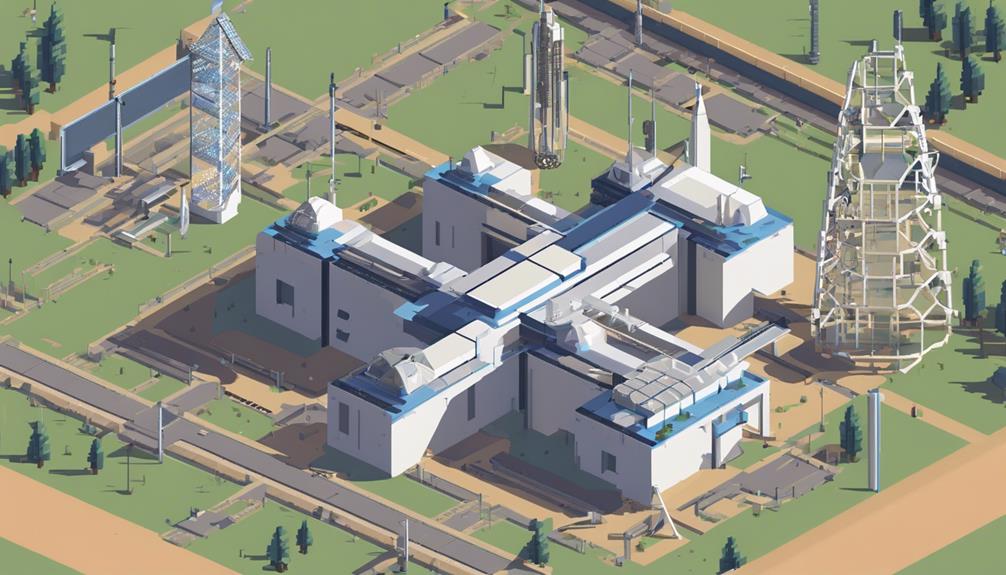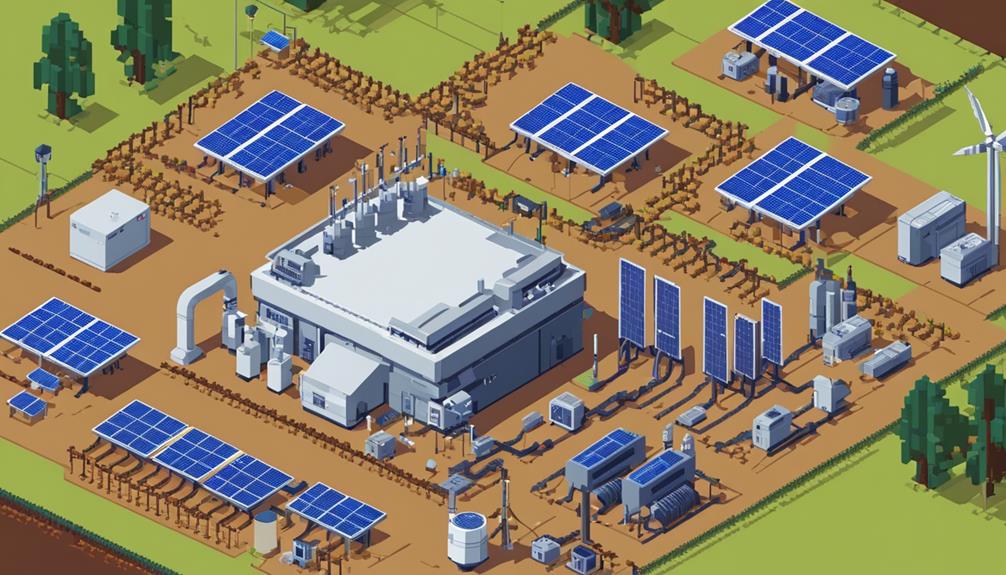The intricate network of components comprising modern ground stations is a testament to the precision and complexity required in satellite communication infrastructure. From the meticulous design of antenna systems to the integration of cutting-edge control mechanisms, each element plays a crucial role in ensuring seamless data transmission and reception. However, beyond the technical intricacies lies a realm of challenges and opportunities that shape the very foundation of ground station architecture. As we explore further, the convergence of technology and design principles illuminates a fascinating landscape where innovation and functionality converge to redefine the future of satellite communication systems.
Key Takeaways
- Advanced antenna systems enhance signal strength and reduce interference for efficient communication.
- Efficient control and data processing techniques ensure optimal operational performance and reliable satellite communication.
- Robust power infrastructure and energy-efficient practices support uninterrupted operations and sustainability.
- Security measures like access control, encryption, and surveillance enhance operational security against cyber threats.
Structural Components

The architecture of modern ground stations is characterized by a combination of essential structural components, including antennas, radomes, equipment shelters, and tracking systems. Antennas play a crucial role in satellite communication by receiving and transmitting signals to and from satellites in orbit. These antennas are strategically positioned to ensure optimal signal reception and data transfer. Radomes, protective enclosures that shield antennas from harsh weather conditions, are integral to maintaining the efficiency and longevity of the antennas. They also contribute to the aerodynamic design of the ground station, reducing wind resistance.
Equipment shelters form another vital component of modern ground stations. These shelters house the hardware, electronics, and power systems necessary for the operation of the ground station. They provide a controlled environment to safeguard the sensitive equipment from environmental factors and ensure uninterrupted functioning. Additionally, tracking systems are employed to precisely align the antennas with orbiting satellites. This alignment is essential for establishing and maintaining effective communication channels for data transfer between the ground station and the satellite.
Antenna Systems
With a focus on optimizing signal strength and reducing interference, modern ground stations leverage advanced antenna systems to enhance satellite communication capabilities. Antenna arrays in these stations enable beamforming techniques, such as Phased Array Antennas and Electronically Steerable Antennas (ESAs), to improve signal strength and reduce interference, ensuring more reliable data transmission. These advanced systems allow for dynamic beam adjustments, enhancing signal quality and capacity while enabling communication with multiple satellites simultaneously. Moreover, the resilience and redundancy provided by antenna arrays ensure that multiple functions can be performed concurrently, offering a safety net in case of failures. By utilizing advanced antenna systems, ground stations can make cost-effective technology choices that not only boost data transmission reliability but also contribute to the overall efficiency of satellite communication systems.
- Improved Signal Strength: Advanced antenna systems enhance signal strength for better communication.
- Precise Interference Reduction: Phased array antennas and ESAs enable precise interference reduction.
- Dynamic Beam Adjustments: Antenna systems allow for dynamic beam adjustments, optimizing signal quality.
- Resilience and Redundancy: Antenna arrays offer resilience and redundancy for uninterrupted operations.
- Cost-Effective Technology: Advanced antenna systems contribute to cost-effective technology choices for enhanced reliability.
Control Systems

Control systems within modern ground stations intricately manage various satellite communication functions, including tracking, telemetry, and data processing, to ensure precise and efficient operations. These systems are vital for accurately pointing antennas towards satellites to establish and maintain effective communication links. By incorporating automation and AI algorithms, control systems optimize operational efficiency by automating routine tasks and adapting to changing conditions in real-time.
One of the key roles of control systems is to enable continuous and reliable communication with satellites in orbit. They are designed to handle complex tasks such as tracking the movement of satellites, collecting telemetry data, and processing information to maintain seamless connectivity. Advanced control systems utilize sophisticated signal processing techniques to enhance the quality of communication signals and minimize interference.
Moreover, control systems in ground stations are equipped with functionalities that allow for the monitoring of satellite parameters and the implementation of adaptive adjustments to optimize performance. By leveraging AI algorithms, these systems can make intelligent decisions to ensure uninterrupted communication and efficient data transmission. Overall, control systems play a crucial role in the seamless operation of modern ground stations, enabling them to function effectively in the dynamic and demanding environment of satellite communication.
Data Processing Units
Within modern ground stations, data processing units serve as critical components responsible for handling extensive volumes of satellite data for analysis and distribution with high-performance processing capabilities. These units are equipped with high-performance processors, memory, and storage to efficiently process and store satellite data. Advanced algorithms and software applications run on these units to extract valuable insights from the satellite data. Real-time processing capabilities enable quick decision-making based on the incoming satellite data streams. Data processing units play a crucial role in ensuring the timely and accurate transmission of mission-critical information from satellites.
- High-performance processors ensure swift data processing
- Advanced algorithms extract valuable insights
- Real-time processing enables quick decision-making
- Software applications enhance data analysis capabilities
- Mission-critical information is accurately transmitted from satellites.
Power Supply Infrastructure

Ground stations rely on robust power supply infrastructure to ensure uninterrupted operations and data transmission. This infrastructure includes a combination of reliable power sources, backup power systems, and energy-efficient practices to maintain continuous functionality. Solar panels are increasingly being integrated into ground station designs to provide sustainable and off-grid power solutions, reducing reliance on traditional power grids. Backup power systems such as generators and batteries play a crucial role in ensuring power redundancy in case of outages, safeguarding the critical operations of ground stations.
| Power Supply Component | Description | Importance |
|---|---|---|
| Solar Panels | Provide sustainable power solutions | Reduce reliance on traditional grids |
| Generators | Essential for backup power systems | Ensure continuous operations |
| Batteries | Store excess power for emergencies | Maintain power redundancy |
Power distribution systems within ground stations are designed to efficiently manage varying power demands from different equipment, optimizing energy usage. Additionally, implementing energy-efficient practices like LED lighting and HVAC systems helps reduce overall power consumption, contributing to cost savings and environmental sustainability. By incorporating these elements into their power supply infrastructure, ground stations can operate effectively even in challenging conditions, ensuring seamless communication with satellites and spacecraft.
Communication Interfaces
Facilitating seamless bidirectional data exchange with satellites, communication interfaces in modern ground stations play a vital role in ensuring efficient communication protocols and frequency bands are supported. Ground station interfaces are the gateway through which crucial data is transmitted to and from satellites, making them a critical component in the satellite communication network. Here are some key aspects of ground station interfaces:
- Support for Various Communication Protocols: Ground station interfaces are designed to be compatible with a wide range of communication protocols to ensure interoperability with different satellite systems.
- Integration of Different Frequency Bands: These interfaces support diverse frequency bands used in satellite communication, allowing for efficient data transmission based on the specific requirements of the mission.
- Efficient Handling of Telemetry Data: Ground station interfaces enable the reception of telemetry data, providing valuable information about the satellite's status and performance.
- Seamless Transfer of Mission Data: Mission-critical data is seamlessly transferred between the ground station and the satellite through these interfaces, ensuring the success of the mission objectives.
- Reliable Connections for Advanced Communication: Advanced communication interfaces play a crucial role in establishing and maintaining reliable connections with satellites in orbit, enhancing the overall efficiency and effectiveness of the communication process.
Tracking and Telemetry Systems

The seamless operation of modern ground stations relies significantly on the precision and efficiency of tracking and telemetry systems, which are instrumental in monitoring satellite movements and collecting vital data on their health and performance. Tracking systems within ground stations utilize antennas to follow the orbital paths of satellites as they move across the sky. These antennas are crucial for maintaining continuous communication links with the satellites in orbit. Telemetry systems, on the other hand, play a vital role in collecting and transmitting real-time data on various aspects of satellite health, performance, and location back to the ground station.
Ground stations employ advanced radar technology and optical tracking systems to ensure precise monitoring of satellites. Radar technology helps in tracking satellites accurately, especially in scenarios where optical tracking may be challenging due to factors like weather conditions or satellite orientation. Telemetry systems provide essential information on satellite status, including power levels, temperature, and subsystem operations. This data is critical for assessing the overall health of the satellite and making informed decisions regarding its operations.
Redundancy Mechanisms
Incorporating redundant systems is a critical aspect of ensuring the continuous and reliable operation of modern ground stations. Redundancy mechanisms play a vital role in maintaining uninterrupted communication and sustaining essential functions such as satellite tracking, data reception, and overall operational efficiency. To achieve this, ground stations implement backup systems and components that automatically switch over in case of primary system failures, ensuring seamless operation without significant downtime. The following key elements contribute to the effectiveness of redundancy mechanisms in ground stations:
- Redundant power supplies: Backup power sources are integral to sustaining operations during power outages or failures, guaranteeing continuous functionality.
- Antennas redundancy: Multiple antennas provide a fail-safe option for signal reception, enabling consistent communication with satellites and other spacecraft.
- Receiver redundancy: Having duplicate receivers ensures that data reception remains unaffected even if one receiver malfunctions, enhancing reliability.
- Processing unit redundancy: Redundant processing units handle data processing tasks, offering a backup in case of failures and supporting the station's operational continuity.
- Automatic switchover systems: Automated mechanisms facilitate the seamless transition between primary and redundant systems, enabling uninterrupted communication and maintaining reliable performance levels.
Security Protocols

Security protocols in modern ground stations encompass crucial measures such as access control, data encryption, and the integration of surveillance systems. Access control measures regulate and manage user permissions within the ground station network. Data encryption methods ensure the confidentiality and integrity of communication data, while surveillance system integration enhances security monitoring capabilities.
Access Control Measures
Access control measures in modern ground stations are crucial for maintaining the integrity and security of sensitive data and resources. Various security protocols are implemented to ensure robust protection against unauthorized access and potential threats. These measures include:
- Secure authentication protocols to restrict unauthorized entry.
- Biometric authentication methods like fingerprint scanning or facial recognition.
- Encryption techniques such as AES (Advanced Encryption Standard) for safeguarding data during transmission and storage.
- Role-based access control (RBAC) systems for efficient management of data access.
- Intrusion detection systems (IDS) that continuously monitor network traffic for suspicious activities, enhancing overall network security within ground station environments.
Data Encryption Methods
Utilizing advanced encryption algorithms is essential in modern ground station operations to secure satellite communication channels effectively. Data encryption methods play a critical role in safeguarding ground stations from cyber threats and ensuring data integrity. Encryption algorithms, such as the Advanced Encryption Standard (AES), are commonly employed to protect satellite communication links. These secure network protocols establish encrypted communication channels, preventing unauthorized access to sensitive mission data. By implementing strong encryption methods, ground stations can maintain the confidentiality and privacy of their satellite communications. The table below provides an overview of some key encryption methods and their importance in securing satellite communication:
| Encryption Method | Importance |
|---|---|
| AES | Widely used for securing satellite communication channels |
| RSA | Ensures data confidentiality and integrity |
| SSL/TLS | Establishes secure connections for data transmission |
| VPN | Secures communication over public networks |
| ECC | Provides efficient encryption for satellite communications |
Surveillance System Integration
Integrating surveillance systems within modern ground stations enhances operational security by enabling real-time monitoring for threat detection and response. This integration is vital in safeguarding against cyber threats and unauthorized access, ensuring the integrity of satellite communications. Advanced security measures such as intrusion detection systems and encryption methods are employed to protect communication networks. Anomaly detection algorithms play a crucial role in identifying any unusual activities that may pose risks to the ground station infrastructure. Moreover, the implementation of secure network protocols adds an extra layer of defense, while continuous monitoring through surveillance system integration further bolsters the overall cybersecurity posture of ground stations.
Frequently Asked Questions
What Are the Basics of Ground Stations?
Ground stations are essential for satellite communication. They involve antenna placement for signal reception, data processing, and adherence to communication protocols. Remote monitoring, equipment maintenance, power supply management, satellite tracking, and weather protection are integral components. Additionally, security measures are implemented to safeguard operations. These stations are strategically located to ensure optimal satellite connectivity, minimal interference, and efficient data transmission.
What Is the Purpose of the Ground Station?
The purpose of a ground station is multifaceted. It serves as a critical interface for data reception, communication link establishment, signal processing, antenna tracking, remote operation, satellite tracking, data transmission, signal reception, network connection, and system integration. These functions are essential for ensuring seamless connectivity between satellites and ground control, enabling efficient data exchange, mission monitoring, and operational management in satellite communications.
What Are the Important Components of Earth Station?
The important components of an Earth station include antenna placement for signal reception, signal processing units for data handling, data transmission systems for communication, power supply units for uninterrupted operation, equipment racks for housing hardware, cooling systems for temperature regulation, remote monitoring capabilities for oversight, security measures for data protection, grounding techniques for safety, and backup systems for redundancy. Each component plays a crucial role in ensuring the efficient functioning of the Earth station.
What Is the Difference Between Ground Station and Earth Station?
In the realm of satellite communication, the distinction between ground stations and earth stations lies in their operational focus and scope. Ground stations primarily facilitate communication with satellites in lower orbits, handling tasks such as tracking, telemetry, and command operations. On the other hand, earth stations are tailored for long-distance communication with spacecraft in deep space, utilizing advanced antenna technology and communication protocols to establish reliable data transmission, signal reception, and remote monitoring capabilities.
